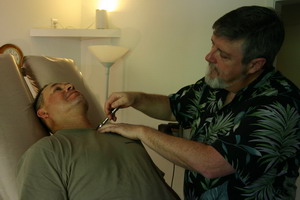 Most of you that read this newsletter have been patients in my office at one time or another. When you come in the first thing I do is lay you down on your back and check your neck. I pull the neck bones forward gently one at a time on the right and the left while using the hand muscle test to see if any of those pulls creates weakness. Why do I do this? It is because virtually every one of my patients has some amount of Tech Neck. When I find a neck bone that creates weakness when pulled forward, I know that a vertebra (neck bone) is displaced forward and irritated. Any aggravation of an irritation anywhere in the body will trigger a brief weakness in all your muscles. I usually test with the hand muscles because they are convenient and do not tire as easily as most other muscles.
Most of you that read this newsletter have been patients in my office at one time or another. When you come in the first thing I do is lay you down on your back and check your neck. I pull the neck bones forward gently one at a time on the right and the left while using the hand muscle test to see if any of those pulls creates weakness. Why do I do this? It is because virtually every one of my patients has some amount of Tech Neck. When I find a neck bone that creates weakness when pulled forward, I know that a vertebra (neck bone) is displaced forward and irritated. Any aggravation of an irritation anywhere in the body will trigger a brief weakness in all your muscles. I usually test with the hand muscles because they are convenient and do not tire as easily as most other muscles.
 What does that test tell me? It shows me that some of your neck vertebrae are pulled forward. This forward movement of the bones in the neck is called Tech Neck. This is the modern name. Back when I was in school, we referred to it as a head forward posture. Now the main cause of this posture is cell phones, laptops, and computers — tech stuff, hence the name. Head forward posture is a concern because of the irritation it causes to the joints in the neck. With time this irritation becomes inflamed and arthritic degeneration of the spine sets in. Years back there was a movement in Chiropractic to rename this process subluxation degeneration because it is the constant movement of a joint that is a bit out of place (subluxation) that creates the degeneration.
What does that test tell me? It shows me that some of your neck vertebrae are pulled forward. This forward movement of the bones in the neck is called Tech Neck. This is the modern name. Back when I was in school, we referred to it as a head forward posture. Now the main cause of this posture is cell phones, laptops, and computers — tech stuff, hence the name. Head forward posture is a concern because of the irritation it causes to the joints in the neck. With time this irritation becomes inflamed and arthritic degeneration of the spine sets in. Years back there was a movement in Chiropractic to rename this process subluxation degeneration because it is the constant movement of a joint that is a bit out of place (subluxation) that creates the degeneration.
 To understand what is going on here, take a heavy book or pot or anything that is a couple of pounds and hold it up with one hand while your elbow is resting on a table. First, hold the object straight up so the weight is directly over your elbow. If you notice, it is not hard to hold this up this way. Now bend the arm out so the weight is not over the elbow. Notice how much more work it takes to hold this object up at this angled position. Your muscles have to work much more and they are much tighter. Well, your head is like the book or pot except it weighs between 12 and 15 pounds. When your head posture is forward, your neck muscles have to work much harder. They will have to use 50 to 100 pounds of force to hold your head in that forward posture. That 50 to 100 pounds is crushing down on your neck joints, jamming them together, and pinching the joint tissues. Naturally, this irritates them. As you move your neck in this posture, those joints are being ground into each other causing degeneration of the joints and the discs.
To understand what is going on here, take a heavy book or pot or anything that is a couple of pounds and hold it up with one hand while your elbow is resting on a table. First, hold the object straight up so the weight is directly over your elbow. If you notice, it is not hard to hold this up this way. Now bend the arm out so the weight is not over the elbow. Notice how much more work it takes to hold this object up at this angled position. Your muscles have to work much more and they are much tighter. Well, your head is like the book or pot except it weighs between 12 and 15 pounds. When your head posture is forward, your neck muscles have to work much harder. They will have to use 50 to 100 pounds of force to hold your head in that forward posture. That 50 to 100 pounds is crushing down on your neck joints, jamming them together, and pinching the joint tissues. Naturally, this irritates them. As you move your neck in this posture, those joints are being ground into each other causing degeneration of the joints and the discs.
 Have any of you experienced any tingling or numbness in the hands? Most of the time this is coming from the compression of the lower part of the spine in the neck, and this is usually the result of Tech Neck. Often times chronic shoulder pain, pain between the shoulder blades, upper arm pain, and elbow pain also come from this same pattern. You may only feel the pain in those areas, but the real source is the neck. Often I see patients that have been told that their tingling fingers are due to carpal tunnel syndrome. The first thing I ask is “does any of the tingling happen in the thumb, first finger, or little finger?“ If the answer is yes then I know that we are not dealing with carpal tunnel. This numbness is a neck issue 95% of the time, and most neck issues come down to Tech Neck.
Have any of you experienced any tingling or numbness in the hands? Most of the time this is coming from the compression of the lower part of the spine in the neck, and this is usually the result of Tech Neck. Often times chronic shoulder pain, pain between the shoulder blades, upper arm pain, and elbow pain also come from this same pattern. You may only feel the pain in those areas, but the real source is the neck. Often I see patients that have been told that their tingling fingers are due to carpal tunnel syndrome. The first thing I ask is “does any of the tingling happen in the thumb, first finger, or little finger?“ If the answer is yes then I know that we are not dealing with carpal tunnel. This numbness is a neck issue 95% of the time, and most neck issues come down to Tech Neck.
 So why is this happening? What is the big deal looking at cell phones and computers? Well, for 99% of human evolution, we used our eyes to look at things 5 feet to 1000 feet away. Go ahead, right now. Look at something 20 feet away. What posture is your head in? In that visual range, our head is up and centered over our shoulders. This is like that book you were holding when the book was directly over your elbow. There is almost no neck muscle tension and the joints are able to freely move without restriction. It was not until humans invented writing that they ever spent much time looking at what was close to their bodies. Looking down at hand level was a very occasional action. Fast forward to the present and you will find large portions of the population will spend the majority of the day focused on activities that are all within arm’s length. Every century for the last 5000 years greater percentages of the population began to engage in activities within arm’s length until now we rarely look out the window even if we have one. Our neck musculature was not designed for this. The whole point of learning to walk upright was to be able to scan the horizon for prey and predators.
So why is this happening? What is the big deal looking at cell phones and computers? Well, for 99% of human evolution, we used our eyes to look at things 5 feet to 1000 feet away. Go ahead, right now. Look at something 20 feet away. What posture is your head in? In that visual range, our head is up and centered over our shoulders. This is like that book you were holding when the book was directly over your elbow. There is almost no neck muscle tension and the joints are able to freely move without restriction. It was not until humans invented writing that they ever spent much time looking at what was close to their bodies. Looking down at hand level was a very occasional action. Fast forward to the present and you will find large portions of the population will spend the majority of the day focused on activities that are all within arm’s length. Every century for the last 5000 years greater percentages of the population began to engage in activities within arm’s length until now we rarely look out the window even if we have one. Our neck musculature was not designed for this. The whole point of learning to walk upright was to be able to scan the horizon for prey and predators.
 So here you have the problem in a nutshell. We are not physically designed to spend our days looking at things up close. When we do, our necks get tight, compressed, and rapidly develop degeneration. Our modern tech has greatly accelerated this process. I was listening to a spine surgeon the other day about this subject. One of the scary things he mentioned was that when he would look at x-rays and MRIs of a neck before seeing a patient for the first time, he would assume the patient was in their mid-sixties from the amount of degeneration that was present. He would then be shocked upon meeting them to find that the patient was only in their 20s or 30s. This head forward posture, the so-called Tech Neck, is rotting the spinal joints away in the neck that early.
So here you have the problem in a nutshell. We are not physically designed to spend our days looking at things up close. When we do, our necks get tight, compressed, and rapidly develop degeneration. Our modern tech has greatly accelerated this process. I was listening to a spine surgeon the other day about this subject. One of the scary things he mentioned was that when he would look at x-rays and MRIs of a neck before seeing a patient for the first time, he would assume the patient was in their mid-sixties from the amount of degeneration that was present. He would then be shocked upon meeting them to find that the patient was only in their 20s or 30s. This head forward posture, the so-called Tech Neck, is rotting the spinal joints away in the neck that early.
 We have one more piece to this puzzle, gaze fixation. As hunter-gatherers our eyes were always scanning the surroundings, looking for food and watching for danger. Neurologically, when we stop scanning and fixate our gaze on one spot, our nervous system switches from relaxation to vigilance. We see something and we switch into action mode. The muscles on the front side of your body tighten up and your breathing gets shallower and faster. This is important because as your body prepares for fight or flight mode, your rib cage drops down and in. Your shoulders roll forward throwing your weight forward as you prepare to move. It is this rolling forward of the upper back and collapsing of the rib cage in the front that actually produces the head forward posture. It is not a neck-caused problem. Yes, the damage happens in the neck, but the real issue is the rib cage and upper back. Notice what happens with your eyes when you are glued to the screen — no scanning. Your eyes are fixated. Your body is not relaxed. In fact, I would not be surprised if this condition is one of the major reasons why stress is such an issue these days.
We have one more piece to this puzzle, gaze fixation. As hunter-gatherers our eyes were always scanning the surroundings, looking for food and watching for danger. Neurologically, when we stop scanning and fixate our gaze on one spot, our nervous system switches from relaxation to vigilance. We see something and we switch into action mode. The muscles on the front side of your body tighten up and your breathing gets shallower and faster. This is important because as your body prepares for fight or flight mode, your rib cage drops down and in. Your shoulders roll forward throwing your weight forward as you prepare to move. It is this rolling forward of the upper back and collapsing of the rib cage in the front that actually produces the head forward posture. It is not a neck-caused problem. Yes, the damage happens in the neck, but the real issue is the rib cage and upper back. Notice what happens with your eyes when you are glued to the screen — no scanning. Your eyes are fixated. Your body is not relaxed. In fact, I would not be surprised if this condition is one of the major reasons why stress is such an issue these days.
 So what is this telling us? First off, if your head is forward, trying to pull your head backward is useless. That will not fix anything. Trying to pinch your shoulder blades back also is no help. What we really want to do is improve our breathing back to a relaxed diaphragm breathing where the ribs expand laterally and the sternum opens forward. This will lift the rounded upper back and set the head back toward where it belongs. It is not about pushing ‘air’ down into the belly. The air needs to expand the chest, not the belly. Here are a couple of videos demonstrating this. The first video is more clinical, the second less so.
So what is this telling us? First off, if your head is forward, trying to pull your head backward is useless. That will not fix anything. Trying to pinch your shoulder blades back also is no help. What we really want to do is improve our breathing back to a relaxed diaphragm breathing where the ribs expand laterally and the sternum opens forward. This will lift the rounded upper back and set the head back toward where it belongs. It is not about pushing ‘air’ down into the belly. The air needs to expand the chest, not the belly. Here are a couple of videos demonstrating this. The first video is more clinical, the second less so.
https://www.youtube.com/watch?v=JIC-l2D_NqI
https://www.youtube.com/watch?v=duuS_WRjYP4
 As you are mastering this type of breathing, you want to make your neck longer and tilt your head down just slightly. As the air from your inhalation expands your chest and your upper back lifts, it raises your collar bones upward releasing tension on the big strap muscles that go from the back of your skull to the collar bones. This will allow the neck to relax back into a proper posture.
As you are mastering this type of breathing, you want to make your neck longer and tilt your head down just slightly. As the air from your inhalation expands your chest and your upper back lifts, it raises your collar bones upward releasing tension on the big strap muscles that go from the back of your skull to the collar bones. This will allow the neck to relax back into a proper posture.
 As I mentioned before, this issue is as much neurological as it is structural. The result of this awareness is that this change needs a lot of practice. You literally have to rewrite tons of neurological pathways. You will be fighting half a million years of evolved neurology that tells us to slump into pounce and run posture whenever we fixate our gaze, particularly on something close to us. As a first step, develop the habit of looking around the room or out a window frequently while on the computer. We are talking about casual looking, not problem-searching. Stop and breathe consciously while engaging tech with full diaphragm breathing. There are many exercises and stretches you can find on the internet that will make things look better for a few minutes to hours, but they are not addressing the underlying cause of Tech Neck. What we are really dealing with is the postural manifestation of integrated primordial reflexes from our ancient past. They become posture habits when they get triggered too often and for too long. We are not designed to be in fight-or-flight mode for more than a few minutes per day. What we are doing with tech makes our bodies think we are in fight-or-flight mode all day long. Tech Neck is the posture of chronic stress reactions that our body is playing out without us even being consciously aware of any stress.
As I mentioned before, this issue is as much neurological as it is structural. The result of this awareness is that this change needs a lot of practice. You literally have to rewrite tons of neurological pathways. You will be fighting half a million years of evolved neurology that tells us to slump into pounce and run posture whenever we fixate our gaze, particularly on something close to us. As a first step, develop the habit of looking around the room or out a window frequently while on the computer. We are talking about casual looking, not problem-searching. Stop and breathe consciously while engaging tech with full diaphragm breathing. There are many exercises and stretches you can find on the internet that will make things look better for a few minutes to hours, but they are not addressing the underlying cause of Tech Neck. What we are really dealing with is the postural manifestation of integrated primordial reflexes from our ancient past. They become posture habits when they get triggered too often and for too long. We are not designed to be in fight-or-flight mode for more than a few minutes per day. What we are doing with tech makes our bodies think we are in fight-or-flight mode all day long. Tech Neck is the posture of chronic stress reactions that our body is playing out without us even being consciously aware of any stress.
 So now you know why I always start every adjustment with you on your back. I want to reset that neck forward posture before I even attempt to look at your back. Plus, it gives me a chance to check out your digestion and hip muscle balance as well.
So now you know why I always start every adjustment with you on your back. I want to reset that neck forward posture before I even attempt to look at your back. Plus, it gives me a chance to check out your digestion and hip muscle balance as well.
Take care,
David
